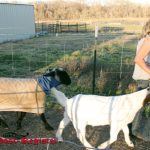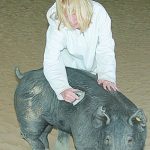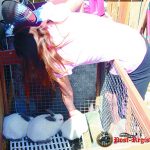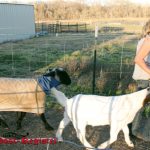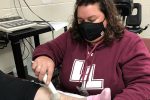Show Girls — From sugar and spice to shoveling….
Story and photos by LPR Staff
With the Caldwell County Junior Livestock Show and Sale only days away, nearly 300 local youth are putting the finishing touches on their projects. In most cases, those finishing touches include bathing and shaving hogs, weighing and shearing goats and making sure steers are halter-broken and tame enough to take into the show ring
– often guided by the steady hands of boys and girls less than half the size of the animals they plan to show.
Though whether they have invested their time and money in large livestock or more manageable, pet-like projects, each youngster planning to participate in this weekend’s Caldwell County Junior Livestock Show is doing so with a plan and a purpose in mind.
Take Hailee Donaldson, 12. Already a seasoned showperson before she started junior high school, Donaldson has been working with her market goat, Hammer, since before Halloween.
“We started training him to set when he was still pretty little,” Donaldson said, planting a kiss on Hammer’s muzzle. “And I walk him every day. He’s not quite where I want him to be, but I think he’s a good goat.”
Donaldson knows all about good goats. Her second year to show, Donaldson raised the Grand Champion goat, which she said she still has, on a pasture near her home outside Lockhart.
“When I pick my goats, I look for their shape,” she said with an air of authority uncommon in someone so young. “You want them to have a rectangle, and you want to look at their backs to make sure they don’t bend, and see how their hams are.”
Unlike many CCJLS participants, Donaldson did not start with a smaller animal, a rabbit or broiler, for example, and then move up to goats and, this year, sheep. Instead, she jumped in with both feet.
“I don’t like rabbits,” she said, tugging on Hammer’s halter as they walked up a rocky slope away from his pen. “I like goats, so I wanted to raise goats.”
Though her mother claimed not to have known anything about goats in the beginning, she said she knew people who bred and raised goats, and those trusted friends have made the process easier – for the entire family.
“It really is a family thing,” Shanna Donaldson said. “Hailee does most of it, she works him and takes care of feeding.”
Shanna pitches in, however, quizzing her daughter about feeding practices and medicines, and helping to exercise Hammer in a round pen near their house. She also keeps track of the money.
“At the end, after the sale, then whatever I pay my mom back for feed and vet bills, and the rest goes in my savings account for college and for my next project,” Hailee said.
In four years, the Donaldsons said, Hailee’s goat project have largely paid for themselves, as well as allowing for extra money to set aside for the future.
Nine-year-old Alyssa Davis, a second-year hog raiser, also uses her show money on things other than next year’s show.
Davis, who shares the work and expense of raising hogs with her best friend, Kobie Bothell, used part of her sale proceeds last year for Girl Scout Camp.
“I don’t really know how much it costs, and how much feed we use and all that,” Davis said while walking her hog, Izzy, around the ring in the Caldwell County Show Barn. “My parents do all that stuff. What I really just do is work the hog, feed her and clean her, and clean up the poop.”
Her younger sisters also help out, she said, as do hers and Bothell’s parents.
“Since we live in town and they live out in the country, the hogs stay out there [on the Bothell’s Delhi-area property]” she said. “Kobie feeds them in the morning, and I go out after school and feed and work with Izzy then.
Unless, of course, the weather prevents it.
“These last few days, when it’s been cold and snowing, of course, we go out there and tend to the hogs,” Laurie Davis said. “I’m not going to take her out on the roads when it’s icy. But other than that, she’s been the one that takes care and does the feeding and works her hog.”
When she started in 4-H, Alyssa said, she wanted to raise goats. Her parents, however, had other ideas.
“I don’t know a thing about goats, and neither does [her husband] Pat,” Laurie said. “But at a certain point, it is about earning back some of the money you invest, and when I raised, hogs always brought more at sale than goats or sheep. So we asked her about hogs, and she said she wanted to try.”
Like any 9-year-old, Alyssa tried to talk her mother into letting her have her way, even as she brushed Izzy’s belly in the show ring.
“But next year, I think I’m going to try to show a goat. I’ve already showed hogs.”
Still, Alyssa understands her hogs, though she names them and plays with them, are projects and not pets.
“After the show, I know she’s going to slaughter,” Alyssa said of Izzy. “And that’s okay. Because last year’s project tasted good!”
Abbe Rougeou, 9, also understands what it means to part with projects at the end of the show – though her pen of meat rabbits won’t go to slaughter.
“We take them back to the breeder after the show, because if we didn’t there would be rabbits all over the place,” she said.
Rougeou started showing rabbits when she was five, as a part of the CCJLS’s Short Term Rabbit Project, a four-week endeavor designed for 5- to 7-year olds who are as yet too young to participate in the main show. The Short Term Rabbit Project gives children the feel of what it’s like to raise an animal, and how it feels to be in the show ring.
“I’ve always loved animals, and I like raising the rabbits,” Abbe said. “They’re fun, and they’re really kind of easier than the other animals.”
Easier, in that unlike Donaldson or Davis, Abbe doesn’t have to exercise her rabbits daily. Still, a pen of market rabbits is a big responsibility, she said, and one that she doesn’t take lightly.
“You really have to make sure that they don’t get sick, and that they get all the food they need without getting too much,” she said. “And that’s kind of… it’s hard. If you have one that gets sick, then everyone in the pen might get sick and that’s going to cost you a lot in vet bills in making them better.”
Rougeou said that it was also important to make sure the rabbits were around the same size, and that each of the three rabbits in a “meat pen” was easy to handle and used to the presence of the exhibitor.
“You have to make sure they know you, because they get nervous, and if they get nervous while you’re showing, it’s just bad,” she said. “But you can pet them and comfort them, and if you cover their eyes, they don’t know where to run, so they just stay where they are and you can calm them down.”
Rougeou and her parents, Melissa and Shawn, have a near-constant exposure to rabbits, as they spend almost as much time in the house as they do in their pen.
“She’s always bringing them inside, either working with them or just hanging out with them,” Melissa said. “They’re not exactly like pets, because we know they’re going back to the breeder after the show, but… they’re around a lot.”
In preparing for the show, each of the three girls had similar plans, despite the differences in their projects.
All three will be quizzed on the feeding regimens, exercise needs and health care concerns of their animals. Each will prepare a log documenting the time and money spent on the project, and each will cross their fingers and hope for a good price at sale.
“After it’s all done, the money goes in my bank account, and that’s what I’ll use to get next year’s rabbits,” Rougeou said. “And maybe some other stuff. But that’s really up to my mom.”
The Caldwell County Junior Livestock Show and Sale will take place at the Caldwell County Show Barn on Reed Drive on Friday and Saturday, Feb. 25-26. The sale begins at 6 p.m. on Saturday, Feb. 26. Donors are still encouraged to contact one of the local buyers’ groups to make a donation toward the purchase of a CCJS project.
